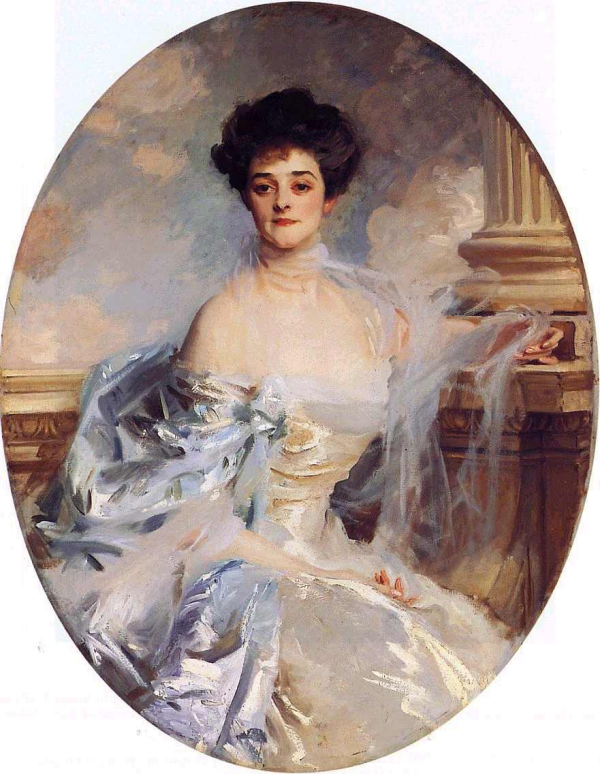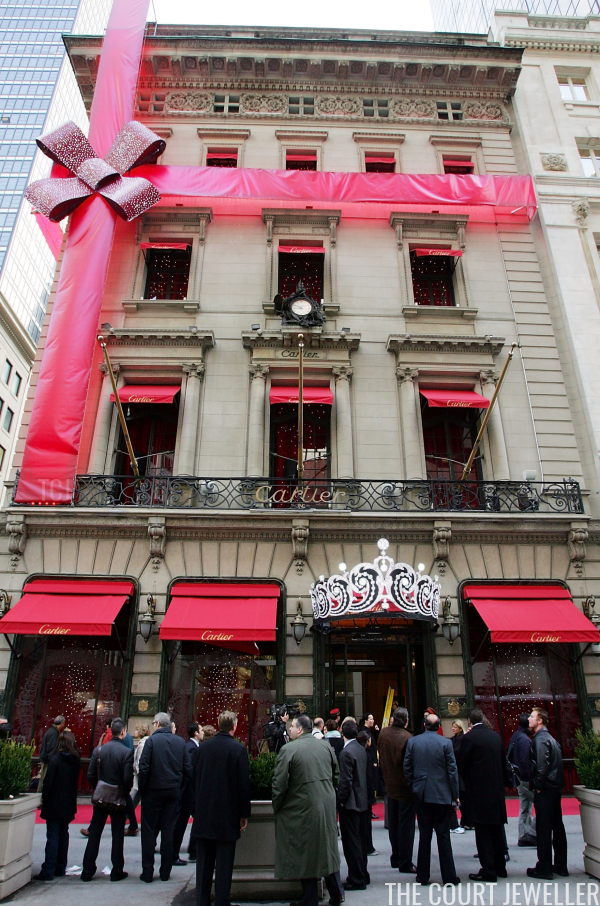 |
| Wikimedia Commons |
The Essex Tiara
 |
| FRANCOIS GUILLOT/AFP/Getty Images |
Tiara designs often fall into two categories: either they stand as a specific example of design from their era, or they manage to transcend that time period. Today’s sparkler, the Essex Tiara, definitely falls into the “timeless” category.
 |
| Wikimedia Commons |
The diamond scroll tiara was made in 1902 by Cartier. It was made with a specific event in mind: the upcoming coronation of King Edward VII. The original wearer of the tiara was as elegant and rich as the tiara’s design: Adele Beach Grant, the American railway heiress who married the 7th Earl of Essex in 1893. The earl bought the tiara for Adele just before the coronation, and she wore it in Westminster Abbey on Coronation Day in August 1902.
 |
| Wikimedia Commons |
American newspapers declared that Adele was “the belle of the coronation,” envied by other peeresses for her “grace and discretion” — as well as her tiara and hairstyle, which featured one long curl carefully resting on her shoulder. She remained a glittering light in London’s aristocratic social world until 1916, when her husband was struck by a taxi and died. The ensuing death duties on the estate forced her to sell off the family’s grand country house and many of its contents, including numerous pieces of fine art. The strain was such that she died of a heart attack in the summer of 1922, shortly after the auction was held.
 |
| Hulton Archive/Getty Images |
Adele’s gorgeous coronation tiara, however, found itself brought back to life again and again by subsequent wearers. The piece even witnessed a second British royal coronation. In 1953, the tiara was borrowed by Clementine Churchill, wife of Sir Winston, who wore it in Westminster Abbey for the coronation of Queen Elizabeth II. (We don’t know precisely who owned the tiara at this point, but clearly they were quite happy to lend the piece to such an important British figure for the event!)

In 1990, the piece was auctioned at Christie’s and bought by a diamond dealer. (Unfortunately, this transaction too is a little shrouded in mystery — we don’t seem to know the name of the purchaser.) The dealer quickly resold the tiara, and to an important buyer: the director of the Cartier Collection. The jewelry firm that made the tiara has owned it every since, and they were happy to loan it out for another important royal occasion. In 1996, Crown Princess Margareta, daughter of the last King of Romania, borrowed the tiara from Cartier for her wedding in Lausanne. An exhibition of Cartier Collection jewels was conveniently mounted in Lausanne in the same year.
 |
| Evan Agostini/Getty Images |
Today, the tiara remains a prominent part of the Cartier Collection, and it is often featured in promotional materials about Cartier’s legacy jewels. In November 2004, to celebrate the 25th anniversary of the Cartier Holiday Bow tradition at the Cartier Mansion on Fifth Avenue, an enormous replica of the tiara was placed above the building’s door.
 |
| Evan Agostini/Getty Images |
For a party at the Cartier mansion during the same holiday season, the tiara itself was an honored guest, featuring in photos with Santa Claus (!) and actress Julianne Moore. (Santa, if you’re listening, the tiara would be a perfect gift for me this Christmas…)
 |
| NICOLAS ASFOURI/AFP via Getty Images |
As it has become such a beloved part of the Cartier Collection, it should come as no surprise that the tiara is often loaned to exhibits around the world. Above, it’s displayed at a museum in Portugal in February 2007, and it has also been included in prominent exhibitions in France and Australia. It was even worn by Rihanna for a photo shoot in 2016!
Queen Marie of Romania’s Sapphire Pendant
 |
| Photo generously shared by Javier; do not reproduce |
In a month dedicated to the glorious sapphire, we’ve already seen a whole lot of incredible examples of royal pieces set with the gemstone. But today, we’ve got a look at what is perhaps the greatest royal sapphire of all, which belonged to two twentieth-century queens.
 |
| JIM WATSON/AFP/Getty Images |
The first records of the sapphire’s existence place it in Cartier’s workshop in Paris around 1913. It was originally set in a sautoir necklace with a number of other sapphires; however, the firm changed the design of the piece to showcase the sapphire as a single pendant on a diamond and platinum necklace. That version of the necklace was put on exhibit in 1919 in San Sebastian, Spain. Hans Nadelhoffer’s book on Cartier notes that the necklace was the showstopper piece of the jeweler’s autumn show that year, and viewers included Queen Ena of Spain and her mother-in-law, Queen Maria Cristina. According to Nadelhoffer, Ena even tried the necklace on, possibly hoping that her husband, King Alfonso, would purchase it for her. (No dice, unfortunately: Alfonso said no.)
 |
| Wikimedia Commons |
Instead, a different monarch ended up buying the necklace: King Ferdinand of Romania. He purchased the necklace in 1921 on an installment plan, paying around 1,375,000 francs in total. (And remember, that’s at a 1920s rate.) Ferdinand was married to the glamorous and dramatic Queen Marie, daughter of Prince Alfred, Duke of Saxe-Coburg and Gotha (a son of Queen Victoria and Prince Albert) and his Romanov wife, Grand Duchess Maria Alexandrovna of Russia. Marie had lost many of her jewels in Russia during the war, and she and Ferdinand were on a mission to replenish her jewelry box.
 |
| Philip de Laszlo’s 1924 portrait of Queen Marie (Wikimedia Commons) |
Ferdinand had succeeded to the Romanian throne in 1914, but his reign had been quickly disrupted by World War I. In 1922, the year after he bought the sapphire, he and Marie were finally crowned. For the October coronation, Marie wore the diamond sautoir with the enormous sapphire pendant. Two years later, she paired the necklace with a diamond and sapphire tiara that she had purchased from one of her Romanov relatives, the famous Grand Duchess Vladimir, for a portrait sitting with Philip de Laszlo.
 |
| Michael and Anne on their wedding day (Wikimedia Commons) |
Even after the end of the war, though, Romanian politics were complex. Ferdinand died in 1927, and his son, Carol, began a tumultuous reign marked by scandal, abdication, and eventual exile. By 1947, Carol’s only son, Michael, was on the throne; he was compelled to abdicate by the government. With the family in increasingly dire straits, the sapphire pendant was sold. The buyer was another major name in jewelry: Harry Winston. (The family actually kept the diamond portion of the necklace for a bit longer. It was worn in 1948 by Princess Anne of Bourbon-Parma at her wedding to King Michael, but it’s since been broken up.)
 |
| Queen Friederike wears the pendant with her pearl and diamond necklace (screencapture) |
The royal story of the sapphire pendant could have ended there — but it didn’t. Vincent Meylan writes that Harry Winston sold the sapphire pendant to a wealthy Greek citizen, who in turn presented it to his nation’s queen consort: Friederike, the wife of King Paul. Friederike often suspended the sapphire from a pearl and diamond necklace. Friederike took the sapphire with her during her 1964 trip to New York.
 |
| Queen Friederike wears the sapphire at a pre-wedding ball for her son, King Constantine II (Keystone Press/Alamy) |
She also wore the piece that September during the wedding festivities for her only son, King Constantine II, and Princess Anne-Marie of Denmark in 1964, and at the wedding of Prince Michael of Greece in 1965. But then, the whereabouts of the sapphire become a bit murky. The Greek monarchy was abolished for good in the 1970s, and the family went into exile. Queen Friederike ended up in Spain, where her daughter, Sofia, was queen, while the king and his family relocated to England. The sapphire popped again in public in November 2003, when it was put up for auction at Christie’s in Geneva. In the auction notes, the lot was offered for sale by “a noble family.”
 |
| JIM WATSON/AFP/Getty Images |
There are basically two ways to interpret that sale note. One is that the Greek royals quietly disposed of the sapphire pendant some time after Queen Friederike’s death, and the piece was purchased by a noble family, who then decided to sell the piece in a public auction. But it’s also entirely possible that these “nobles” were indeed the former Greek royals themselves. It’s pretty common for royals to present items for auction under slightly pseudonymous conditions. There’s a fine line to be trodden: items that have established royal provenance and links to current royal owners sell for higher prices at auction, but selling royal jewelry can lead to some backlash, especially when a piece was a gift from a generous countryman. (For an example, see the excellent work of my friends over at Luxarazzi on the announced sale, then the cancellation of the sale, and then ultimately the eventual auction of many of the jewels of the late Grand Duchess Josephine-Charlotte of Luxembourg.)
 |
| Photo generously shared by Nancy; do not reproduce |
Queen Marie and Queen Friederike’s sapphire pendant was the largest sapphire ever offered at auction when it was sold. When the gavel fell, the jewel had fetched more than $1.4 million. It’s owned privately today, but in 2014, the sapphire went on display as a part of the Cartier: Style and History exhibition in Paris. It was also recently exhibited in Canberra. Nearly a hundred years after it sparkled in Spain at Cartier’s autumn show, the sapphire pendant is dazzling public viewers all over again.
- « Previous Page
- 1
- 2
- 3
- 4
- 5
- …
- 22
- Next Page »